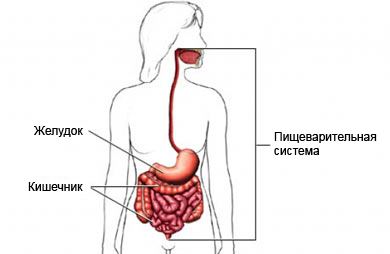Gastrointestinal bleeding – Bleeding from the gastrointestinal tract
Description of bleeding from the gastrointestinal tract
Bleeding from the gastrointestinal tract (GI) – bleeding in the digestive tract.

Pishtevaritelynыy room divided into two areas: upper and lower gastrointestinal tract.
Upper digestive tract includes:
- Esophagus (muscular tube, through which food comes from the throat to the stomach);
- Stomach;
- The upper part of the small intestine.
The lower part of the gastrointestinal tract includes:
- The lower part of the small intestine;
- Colon;
- Anus.
Gastrointestinal bleeding is a serious disorder, which requires a reference to the doctor.
Causes of bleeding from the gastrointestinal tract
Gastrointestinal bleeding is a symptom of a number of possible diseases. Some of the causes of bleeding include:
In the upper digestive tract:
- Peptic ulcer disease – pain in the mucosa of the stomach or upper part of the small intestine;
- Varicose veins of the esophagus – abnormal swelling of the veins in the lining of the esophagus;
- Mallory-Weiss syndrome – gap esophageal mucosa;
- Gastritis – inflammation and ulceration in the gastric mucosa;
- Esophagitis – inflammation and ulcers in the lining of the esophagus;
- Benign tumors – abnormal growth of non-cancerous tissue;
- Cancer – esophageal carcinoma, the stomach or small intestine.
In the lower part of the gastrointestinal tract:
- Angiodysplasia of the intestine – abnormal growth of blood vessels in the intestine;
- Diverticulum – pocket, which is formed on the walls of the colon (If the pocket is inflamed, it is called diverticulitis);
- Colitis – inflammation of the colon;
- Hemorrhoids – varicose veins in the anus or rectum;
- Cracks, tears in the anus;
- Polyps (abnormal growths) or colon cancer.
Risk factors for bleeding from the gastrointestinal tract
Risk factors include:
- Alcohol consumption;
- Long-term use of steroids, blood-thinning medicines, non-steroidal anti-inflammatory drugs (NSAIDs) or aspirin;
- Smoking;
- Previous gastrointestinal or vascular surgery;
- Previous gastrointestinal bleeding;
- Have ulcers;
- Bacterial infections (Helicobacter pylori);
- Age (this risk is also increased in elderly patients, who take painkillers).
Symptoms of bleeding from the gastrointestinal tract
Given the symptoms can not be associated with hemorrhage of DIGESTIVE TRACT, but due to other disorders. If you experience any of these symptoms, consult a doctor.
Symptoms of bleeding from the upper gastrointestinal tract:
- Blood in the vomit;
- Vomiting, It looks like coffee grounds;
- Black, tarry stools;
- Blood in the stool.
Symptoms of bleeding from the lower gastrointestinal tract:
- Black, tarry stools;
- Blood in the stool.
A small amount of blood in the stool can be difficult to notice. Your doctor may order tests, to find it.
Sometimes bleeding can occur suddenly and be very serious. It can cause the following symptoms:
- Weakness;
- Dizziness or weakness;
- Breathlessness;
- Abdominal pain;
- Diarrhea;
- Paleness.
Easy bleeding for a long period of time can cause fatigue and breathlessness.
Diagnosis of bleeding from the gastrointestinal tract
The doctor will ask about your symptoms and medical history, and perform a physical examination. He will try to find the location and cause of bleeding.
Tests may include:
- Blood tests;
- Alcohol testing;
- Analysis of the chair (checking for the presence of blood in the stool);
- Endoscopy – throat inserted a thin tube, to investigate the gastro-intestinal tract and collect tissue samples;
- Colonoscopy – a thin tube inserted through the rectum into the colon to study colonic mucosa;
- Computed tomography of the abdomen – type of X-ray, which uses computer, structures to make images of the gastrointestinal tract;
- Nasogastric lavage – through a tube, placed through the nose into the stomach of its contents are removed to check for blood;
- X-ray with barium – a special X-ray method, performed after, the patient drinks a chemical called barium sulfate;
- Radionuclide scanning – use of small amounts of radioactive material to take pictures of blood flow of the gastrointestinal tract;
- Angiography – X-rays of blood vessels.
Treatment of bleeding from the gastrointestinal tract
If the doctor can determine the cause of bleeding, He will be assigned the best method of treatment. Your doctor may prescribe medication (eg, proton pump inhibitors, Acid suppressors).
Treatment options for stopping bleeding include:
Endoscopy
To stop bleeding may be used endoscopy. With the endoscope (tube, which is inserted in the mouth and intestine), your doctor may stop the bleeding, using various methods:
- Introduction injecting chemicals to close the gap bleeding;
- The use of heat, an electric current or a laser for hemostasis;
- Using the tightening clamps or clips, to close blood vessels.
Angiography
Angiography, which is also used as a diagnostic tool, can help stop bleeding. The doctor may use angiography (X-rays of blood vessels), as well as other tools, to find and bleeding by administration of injecting drugs or other materials into the blood vessels to stop him.
Sometimes, if these treatments are ineffective, It can be scheduled for surgery.
Prevention of bleeding from the gastrointestinal tract
To reduce the risk of gastrointestinal bleeding, necessary to reduce the presence of conditions, that cause them:
- Bacteria H.pylori, infection;
- Gastroesophageal reflux disease (GERD);
- Ulcer;
- Hemorrhoids;
- Polyps;
- Inflammatory bowel disease.
We need to discuss these and other possible conditions, which can cause gastrointestinal bleeding with the doctor, to identify, how to prevent them. It is also recommended to reduce the use of:
- Alcohol;
- Tobacco;
- NSAIDs (if possible).
